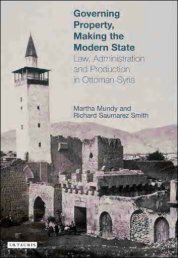Legal borrowing and its impact on Ottoman legal culture in ... - PSI424
Legal borrowing and its impact on Ottoman legal culture in ... - PSI424
Legal borrowing and its impact on Ottoman legal culture in ... - PSI424
You also want an ePaper? Increase the reach of your titles
YUMPU automatically turns print PDFs into web optimized ePapers that Google loves.
AVI RUBIN<br />
Interests embedded <strong>in</strong> local circumstances <str<strong>on</strong>g>and</str<strong>on</strong>g> social networks, normally<br />
hidden from the historian’s gaze, surely were at play. Given the present<br />
state of research <str<strong>on</strong>g>and</str<strong>on</strong>g> the available historical evidence, we are bound to<br />
make do with <strong>in</strong>direct <strong>in</strong>dicati<strong>on</strong>s c<strong>on</strong>cern<strong>in</strong>g the preference of litigants<br />
with respect to forum<br />
Several historians have identified the elusive nature of the demarcati<strong>on</strong><br />
l<strong>in</strong>es between the civil Nizamiye court <str<strong>on</strong>g>and</str<strong>on</strong>g> the Shari’a court dur<strong>in</strong>g the late<br />
n<strong>in</strong>eteenth century. Accord<strong>in</strong>g to comm<strong>on</strong> wisdom, this situati<strong>on</strong>, as well<br />
as the double role of the naib (the Shari’a judge who presided <strong>in</strong> both the<br />
Shari’a <str<strong>on</strong>g>and</str<strong>on</strong>g> civil Nizamiye courts) derived from a supposedly <strong>Ottoman</strong><br />
failure to achieve an absolute separati<strong>on</strong> between the so-called ‘secular’<br />
(Nizamiye) <str<strong>on</strong>g>and</str<strong>on</strong>g> ‘religious’ courts due to lack of means <str<strong>on</strong>g>and</str<strong>on</strong>g> manpower. 79<br />
However, it seems to me that expla<strong>in</strong><strong>in</strong>g this situati<strong>on</strong> <strong>in</strong> terms of bureaucratic<br />
<strong>in</strong>competence or failure is problematic. In fact, there is evidence<br />
that by 1890 the Nizamiye system enjoyed a sufficient number of officials<br />
who had passed qualify<strong>in</strong>g exams that enabled them to be regarded as<br />
professi<strong>on</strong>al Nizamiye pers<strong>on</strong>nel. Eventually, there were more certified<br />
c<str<strong>on</strong>g>and</str<strong>on</strong>g>idates for Nizamiye judicial positi<strong>on</strong>s than vacant positi<strong>on</strong>s. This<br />
situati<strong>on</strong> required the M<strong>in</strong>istry of Justice to <strong>in</strong>struct the nom<strong>in</strong>at<strong>in</strong>g<br />
committees to avoid approval of c<str<strong>on</strong>g>and</str<strong>on</strong>g>idates before positi<strong>on</strong>s were made<br />
available. 80 Yet the official yearbooks (salname) dem<strong>on</strong>strate that the<br />
naibs’ dual-role policy rema<strong>in</strong>ed unchanged throughout the Hamidian<br />
period. It is true that after the close of the Hamidian period (1909), which<br />
marked the end of 600 years of Osmanlı rule, <strong>legal</strong> <str<strong>on</strong>g>and</str<strong>on</strong>g> political transformati<strong>on</strong><br />
started tak<strong>in</strong>g new directi<strong>on</strong>s that also <strong>in</strong>cluded a c<strong>on</strong>scious<br />
effort to separate between the Shar’i <str<strong>on</strong>g>and</str<strong>on</strong>g> Nizami doma<strong>in</strong>s. But this was<br />
really a new age. The Hamidian reformers, while enthusiastically refashi<strong>on</strong><strong>in</strong>g<br />
the Nizamiye court system <strong>in</strong> accordance with French law,<br />
ma<strong>in</strong>ta<strong>in</strong>ed, c<strong>on</strong>sciously or not, the time-h<strong>on</strong>oured <strong>Ottoman</strong> bureaucratic<br />
<str<strong>on</strong>g>and</str<strong>on</strong>g> judicial flexibility. Even though the new codificati<strong>on</strong> projects of the<br />
n<strong>in</strong>eteenth century presented a model quite different from the venerable<br />
comb<strong>in</strong>ati<strong>on</strong> of Kanun (<strong>Ottoman</strong> sultanic law) <str<strong>on</strong>g>and</str<strong>on</strong>g> Shari’a, the reformers<br />
endorsed the noti<strong>on</strong> of <strong>in</strong>divisible spheres. The boundaries between<br />
Kanun, Shari’a <str<strong>on</strong>g>and</str<strong>on</strong>g> customary law had always been elusive. 81<br />
IV. CONCLUSION<br />
In <str<strong>on</strong>g>its</str<strong>on</strong>g>elf, acknowledg<strong>in</strong>g the dynamics of <strong>legal</strong> <str<strong>on</strong>g>borrow<strong>in</strong>g</str<strong>on</strong>g> <strong>in</strong> the <strong>Ottoman</strong><br />
Empire offers limited explanatory value for underst<str<strong>on</strong>g>and</str<strong>on</strong>g><strong>in</strong>g the socio<strong>legal</strong><br />
realities of the late n<strong>in</strong>eteenth century. But acknowledg<strong>in</strong>g the worldwide<br />
ubiquity of the practice of <strong>legal</strong> <str<strong>on</strong>g>borrow<strong>in</strong>g</str<strong>on</strong>g> does allow us to sidestep the<br />
usual preoccupati<strong>on</strong> with the noti<strong>on</strong> of ‘Westernizati<strong>on</strong>’, a c<strong>on</strong>venti<strong>on</strong><br />
296












